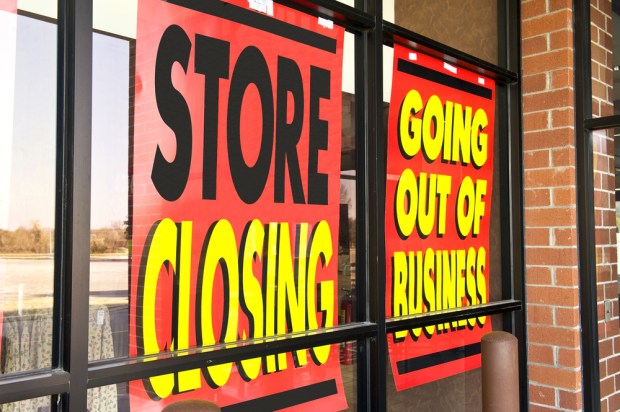Why Toys R Us May Signal The Start Of An Insolvency Spike

It was a coincidental happening that the same month Atradius released its latest insolvency forecast – which found that insolvencies around the world are low, thanks to a strong economic outlook and low interest rates – news of the Toys R Us bankruptcy hit the headlines and sent shockwaves throughout its supply chain.
The backlash continues, as suppliers have reportedly criticized ongoing bankruptcy proceedings that could lead to the defunct retailer leaving more than $450 million in invoices unpaid to suppliers.
The fiasco emphasizes the impact that global insolvency rates have on ongoing crises of late supplier payments. And according to Douglas Collins, the vice president and regional director of risk services for Atradius Americas, the global market is probably headed for an upswing in insolvencies and repeats of Toys R Us’ ongoing troubles.
“The big thing is that we reached the bottom,” Collins recently told PYMNTS in a discussion about Atradius’ March 2018 insolvency forecast.
Analysis predicts a 3 percent decline in insolvencies for 2018, making it the ninth consecutive year in which the rates have dropped. Atradius attributed this trend to ongoing economic growth and optimism, coupled with continuously suppressed interest rates.
But there is bad news that goes along with this report: It won’t last.
“Bankruptcy rates have been declining since the global financial crisis, and I think they’ve reached a floor,” said Collins. “Over the last three to four months, we’ve actually seen an uptick in insolvency activity in our portfolio. Partly, we think that’s because interest rates are starting to go up.”
Competition, Economics and Geopolitics
Rising interest rates are only one part of a complex picture of insolvency trends, however.
Collins explained that one of the largest factors leading to a probable rise in insolvencies is what he calls the “Amazon effect” – the inability for giant retailers to compete with digital rivals like Amazon and Walmart.
Toys R Us “certainly” falls into that category, he said.
“A lot of retailers in the U.S. file for Chapter 11 because of their inability to compete with the Amazons and the Walmarts of the world,” said Collins.
The retailer is proof positive that a positive economic outlook and low interest rates aren’t the only factors that impact insolvency.
“There are financial factors like interest rates and debt servicing, but there are also competitive dynamics, like the Amazon effect,” noted Collins.
Of course, there are geopolitical factors, too, that have massive implications for the health and vitality of organizations around the globe.
Brexit is among the most obvious examples, and even in Atradius’ latest report, its implications are unmissable. According to the research, while economic growth in the U.K. surpassed forecasts, growing at 1.8 percent in 2017, the market saw a 2 percent increase in insolvency rates.
The U.K.’s current climate demonstrates the power of geopolitics over economic factors.
“Higher global economic growth and Sterling depreciation, benefitting U.K. export competitiveness, have contributed to very positive business surveys,” Atradius said in its report. “In spite of this, investment has been constrained amid uncertainty related to Brexit. Insolvencies ticked up for the second year in a row.”
Collins explained that geopolitical events like Brexit end up having an impact on the economy at large, which, in turn, affects insolvency rates.
“Projections and analysis of Brexit expect economic growth to negatively impact insolvency and default rates in the U.K.,” he said. “There is less consumer spending and less consumer confidence, and there has been a rash of retail bankruptcies in the U.K. through the end of last year, though it’s not only because of Brexit – there are other things happening.”
Other geopolitical factors like tariffs and trade wars, he said, are similarly contributing to this turnaround, likely to yield an increase in insolvencies in the coming years.
Suppliers’ Worst Nightmare
Toys R Us is the latest example of the domino effect of a major bankruptcy that not only affects the company itself, but its entire supply chain.
While insolvency rates have declined in recent years, separate research from Atradius suggests B2B payment practices have worsened. Its Payment Practices Barometer survey in 2016 found that 92 percent of businesses have been paid late, and 40 percent said they have had to delay their own supplier payments because of it.
Insolvency rates and late payments are undeniably related – whether insolvency leads to late payments, or late payments lead a supplier to collapse – but Collins said late payments don’t necessarily predict an impending insolvency.
That’s especially true in the U.S., where suppliers can petition a court to push a corporate customer into bankruptcy if they aren’t paying their debts. In other markets, however, a long period of habitually late supplier payments can often be a good indicator of default risk and insolvency.
“Usually, companies try to stay up to date with supplier payments right up to the point they go and file for bankruptcy,” Collins said of U.S. firms.
Toys R Us has vowed to do everything it can to continue paying suppliers, though with the corporations bearing more than $5 billion in debt, it’s no guarantee. Considering analysts’ predictions that insolvency rates are headed for an upswing, Collins said corporates have to stay aware and educated to avoid insolvency and the negative effects it spreads down the supply chain.
“Interest rates are going up, and debt servicing costs will go up as well, which can trigger bankruptcies. I think this is cause to be more vigilant than in the past,” he said. “There is more downside risk looking at this into next year. We may have reached the bottom of the cycle in terms of bankruptcies.”